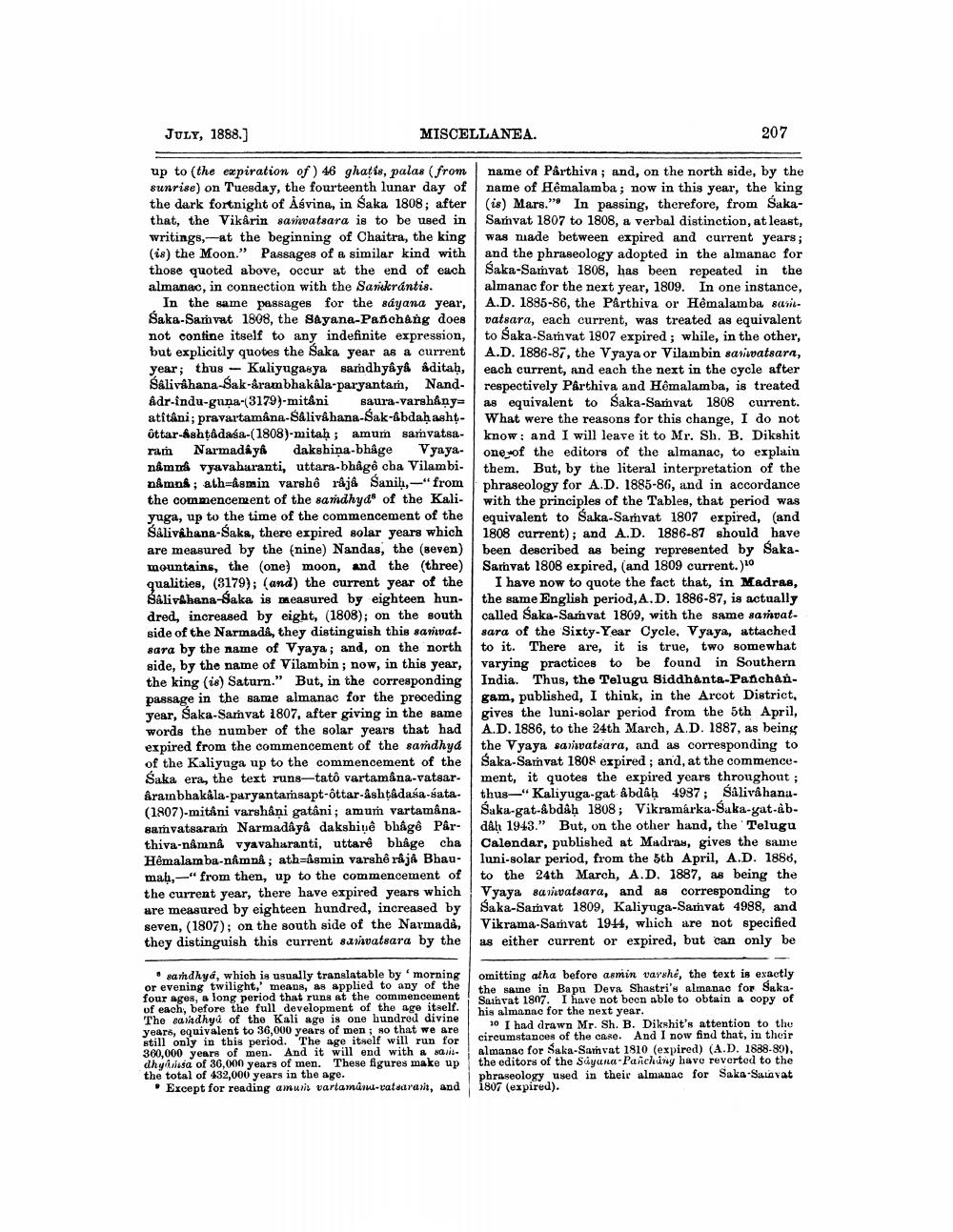________________
JULY, 1888.]
MISCELLANEA.
207
up to the expiration of ) 46 ghatis, palas (from sunrise) on Tuesday, the fourteenth lunar day of the dark fortnight of Åsvina, in Saka 1808; after that, the Vikärin samvatsara is to be used in writings,- at the beginning of Chaitra, the king (is) the Moon." Passages of a similar kind with those quoted above, occur at the end of each almanac, in connection with the Sankrantis.
In the same passages for the sáyana year, Saka-Samvat 1808, the Sayana-Panchang does not contine itself to any indefinite expression, but explicitly quotes the Saka year as a current year; thus - Kuliyugasya samdhyâya åditah, SAlivahana-Sak-arambhakala-paryantam, NandAdr-indu-guna-(3179)-mitâni saura-varshany= atitâni; pravartamâna-Salivahana-Sak-abdah ashtOttar-&shtadasa-(1808)-mitaḥ; amum samvatsaram Narmada ya dakshina-bhåge Vyaya. namna vyavaburanti, uttara-bhago cha Vilambi. námna; ath=asnain varshê råjå Sanih, -" from the commencement of the saṁdhyds of the Kali. yuga, up to the time of the commencement of the Salivahana-Saka, there expired solar years which are measured by the nine) Nandas, the seven) mountains, the (one) moon, and the (three) qualities, (3179); (and) the current year of the Salivahana-Saka is measured by eighteen hun. dred, increased by eight, (1808); on the south side of the Narmada, they distinguish this sanwat. sara by the name of Vyaya; and, on the north side, by the name of Vilambin; now, in this year, the king (is) Saturn." But, in the corresponding passage in the same almanac for the preceding year, Saka-Samvat 1807, after giving in the same words the number of the solar years that had expired from the commencement of the sandhya of the Kaliyuga up to the commencement of the Saka era, the text runs—tato vartamâna-vatsar. Arambhakala-paryantamsapt-êttar-Ashtadasa-sata. (1807)-mitâni varshini gatâni; amur vartamânasamvatsararh Narmada ya dakshinê bhagê Pêrthiva-namna vyavaharanti, uttare bhåge cha Hêmalamba-namna; ath=asmin varshô rájA Bhau. mah," from then, up to the commencement of the current year, there have expired years which are measured by eighteen hundred, increased by seven, (1807); on the south side of the Narmada, they distinguish this current samvatsara by the
name of Parthiva; and, on the north side, by the name of Hêmalamba; now in this year, the king (is) Mars." In passing, therefore, from SakaSarvat 1807 to 1808, a verbal distinction, at least, was niade between expired and current years; and the phraseology adopted in the almanac for Saka-Samvat 1808, has been repeated in the almanac for the next year, 1809. In one instance, A.D. 1885-86, the Parthiva or Hêmalam ba sarivatsara, each current, was treated as equivalent to Saka-Samvat 1807 expired; while, in the other, A.D. 1886-87, the Vyaya or Vilambin sariwatsara, each current, and each the next in the cycle after respectively Parthiva and Hêmalamba, is treated as equivalent to Saka-Samvat 1808 current. What were the reasons for this change, I do not know: and I will leave it to Mr. Sh. B. Dikshit one of the editors of the almanac, to explain them. But, by the literal interpretation of the phraseology for A.D. 1885-86, and in accordance with the principles of the Tables, that period was equivalent to Saka-Samvat 1807 expired, and 1808 current); and A.D. 1886-87 should have been described as being represented by SakaSamvat 1808 expired, (and 1809 current.)
I have now to quote the fact that, in Madras, the same English period, A.D. 1886-87, is actually called Saka-Samvat 1869, with the same samvatsara of the Sixty-Year Cycle, V yaya, attached to it. There are, it is true, two somewhat varying practices to be found in Southern India. Thus, the Telugu Siddhanta-Panchangam, published, I think, in the Arcot District, gives the luni-solar period from the 5th April, A.D. 1886, to the 24th March, A.D. 1887, as being the Vyaya sarwatsara, and as corresponding to Saka-Sarnvat 1808 expired; and, at the commencement, it quotes the expired years throughout ; thus—"Kaliyuga-gat åbdah 4987; Saliva hanaSuka-gat-abdah 1808; Vikramárka-Suka-yat-bdah 1943." But, on the other hand, the Telugu Calendar, published at Madras, gives the same luni-solar period, from the 5th April, A.D. 1886, to the 24th March, A.D. 1887, as being the Vyaya sanatsara. and as corresponding t Saka-Sanvat 1809, Kaliyuga-Samvat 4988, and Vikrama-Samvat 1944, which are not specified as either current or expired, but can only be
sandhyd, which is usually translatable by morning or evening twilight,' means, as applied to any of the four ages, a long period that runs at the commencement of each, before the full development of the age itself. The saradhyů of the Kali age is one hundred divine years, equivalent to 36,000 years of men ; so that we are still only in this period. The age itself will run for 360,000 years of men. And it will end with a waisdhylsa of 36,000 years of men. These figures make up the total of 432,000 years in the age.
. Except for rending amuris vartamúru-raturan, and
omitting atha before armin varshe, the text is exactly the same in Bapu Deva Shastri's almanac for SakaSainrat 1807. I have not been able to obtain a copy of his almanac for the next year.
10 I had drawn Mr. Sh. B. Dikshit's attention to the circumstances of the case. And I now find that, in their almanac for Saka-Sarvat 1810 (expired) (A.D. 1888-89), the editors of the Sayana Panchany have revertod to the phraseology used in their almanac for Saka-Sutavat 1807 (expired).




